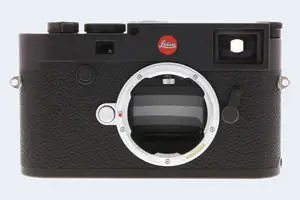Canon G3 X vs Leica M10
The Canon PowerShot G3 X and the Leica M10 (Typ 3656) are two digital cameras that were officially introduced, respectively, in June 2015 and January 2017. The G3X is a fixed lens compact, while the M10 is a rangefinder-focusing mirrorless. The cameras are based on an one-inch (G3X) and a full frame (M10) sensor. The Canon has a resolution of 20 megapixels, whereas the Leica provides 23.8 MP.
Below is an overview of the main specs of the two cameras as a starting point for the comparison.

Check G3X offers at
ebay.com

Check M10 offers at
ebay.com
Going beyond this snapshot of core features and characteristics, what are the differences between the Canon PowerShot G3 X and the Leica M10 (Typ 3656)? Which one should you buy? Read on to find out how these two cameras compare with respect to their body size, their imaging sensors, their shooting features, their input-output connections, and their reception by expert reviewers.
Body comparison
The side-by-side display below illustrates the physical size and weight of the Canon G3 X and the Leica M10. The two cameras are presented according to their relative size. Three successive views from the front, the top, and the rear are shown. All size dimensions are rounded to the nearest millimeter.
The M10 can be obtained in two different colors (black, silver), while the G3X is only available in black.
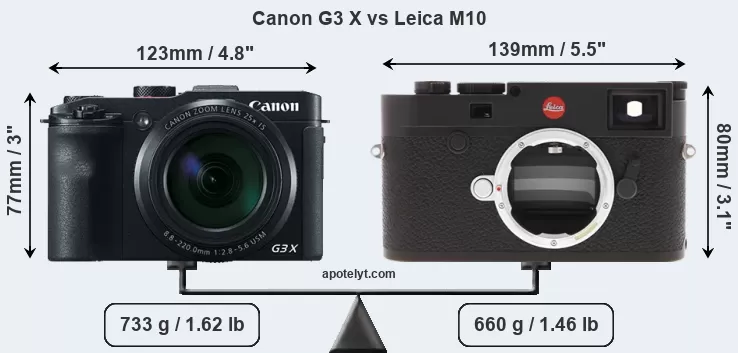
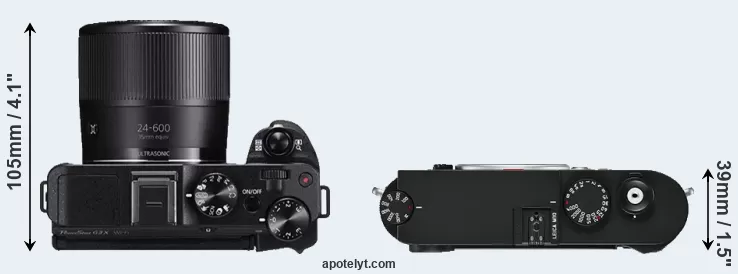
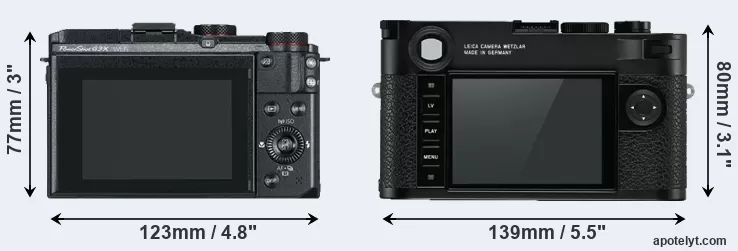
If the front view area (width x height) of the cameras is taken as an aggregate measure of their size, the Leica M10 is notably larger (17 percent) than the Canon G3 X. In this context, it is worth noting that both cameras are splash and dust-proof and can, hence, be used in inclement weather conditions or harsh environments.
The above size and weight comparisons are to some extent incomplete and possibly misleading, as the G3X has a lens built in, whereas the M10 is an interchangeable lens camera that requires a separate lens. Attaching the latter will add extra weight and bulk to the setup. You can compare the optics available for the M10 and their specifications in the Leica M Lens Catalog.
Concerning battery life, the G3X gets 300 shots out of its Canon NB-10L battery, while the M10 can take 210 images on a single charge of its Leica BP-SCL5 power pack.
The table below summarizes the key physical specs of the two cameras alongside a broader set of comparators. If you would like to visualize and compare a different camera combination, you can navigate to the CAM-parator app and make your selection from a broad list of cameras there.

| # | Camera Model |
Camera Width |
Camera Height |
Camera Depth |
Camera Weight |
Battery Life |
Weather Sealing |
Camera Launch |
Launch Price (USD) |
Street Price |
|
|---|---|---|---|---|---|---|---|---|---|---|---|
| 1. | Canon G3 X | 123 mm | 77 mm | 105 mm | 733 g | 300 | Y | Jun 2015 | 999 | ebay.com | |
| 2. | Leica M10 | 139 mm | 80 mm | 39 mm | 660 g | 210 | Y | Jan 2017 | 6,595 | ebay.com | |
| 3. | Canon 80D | 139 mm | 105 mm | 79 mm | 730 g | 960 | Y | Feb 2016 | 1,199 | ebay.com | |
| 4. | Canon G9 X | 98 mm | 58 mm | 31 mm | 209 g | 220 | n | Oct 2015 | 529 | ebay.com | |
| 5. | Canon G7 X | 103 mm | 60 mm | 40 mm | 304 g | 210 | n | Sep 2014 | 699 | ebay.com | |
| 6. | Canon 70D | 139 mm | 104 mm | 79 mm | 755 g | 920 | Y | Jul 2013 | 1,199 | ebay.com | |
| 7. | Leica M11 | 139 mm | 80 mm | 39 mm | 640 g | 700 | Y | Jan 2022 | 8,995 | amazon.com | |
| 8. | Leica M-E Typ 240 | 139 mm | 80 mm | 42 mm | 680 g | 500 | Y | Jun 2019 | 3,999 | ebay.com | |
| 9. | Leica M10-P | 139 mm | 80 mm | 39 mm | 660 g | 210 | Y | Aug 2018 | 7,995 | ebay.com | |
| 10. | Leica M Typ 262 | 139 mm | 80 mm | 42 mm | 680 g | 400 | Y | Nov 2015 | 5,195 | ebay.com | |
| 11. | Leica M Typ 240 | 139 mm | 80 mm | 42 mm | 680 g | 500 | Y | Sep 2012 | 6,950 | ebay.com | |
| 12. | Panasonic FZ2500 | 138 mm | 102 mm | 135 mm | 915 g | 350 | n | Sep 2016 | 1,199 | amazon.com | |
| 13. | Panasonic FZ1000 | 137 mm | 99 mm | 131 mm | 831 g | 360 | n | Jun 2014 | 899 | ebay.com | |
| 14. | Sony RX10 III | 133 mm | 94 mm | 127 mm | 1051 g | 420 | Y | Mar 2016 | 1,499 | ebay.com | |
| 15. | Sony RX100 V | 102 mm | 58 mm | 41 mm | 299 g | 220 | n | Oct 2016 | 999 | ebay.com | |
| 16. | Sony RX10 II | 129 mm | 88 mm | 102 mm | 813 g | 400 | Y | Jun 2015 | 1,299 | ebay.com | |
| 17. | Sony RX10 | 129 mm | 88 mm | 102 mm | 813 g | 420 | Y | Oct 2013 | 1,299 | ebay.com | |
| Note: Measurements and pricing do not include easily detachable parts, such as add-on or interchangeable lenses or optional viewfinders. | |||||||||||
Any camera decision will naturally be influenced heavily by the price. The retail prices at the time of the camera’s release place the model in the market relative to other models in the producer’s line-up and the competition. The G3X was launched at a lower price than the M10, despite having a lens built in. Usually, retail prices stay at first close to the launch price, but after several months, discounts become available. Later in the product cycle and, in particular, when the replacement model is about to appear, further discounting and stock clearance sales often push the camera price considerably down.
Sensor comparison
The size of the sensor inside a digital camera is one of the key determinants of image quality. A large sensor will tend to have larger individual pixels that provide better low-light sensitivity, wider dynamic range, and richer color-depth than smaller pixel-units in a sensor of the same technological generation. Moreover, a large sensor camera will give the photographer more control over depth-of-field in the image and, thus, the ability to better isolate a subject from the background. On the downside, larger sensors are more costly to manufacture and tend to lead to bigger and heavier cameras and lenses.
Of the two cameras under consideration, the Canon G3 X features an one-inch sensor and the Leica M10 a full frame sensor. The sensor area in the M10 is 638 percent bigger. As a result of these sensor size differences, the cameras have a format factor of, respectively, 2.7 and 1.0. Both cameras have a native aspect ratio (sensor width to sensor height) of 3:2.
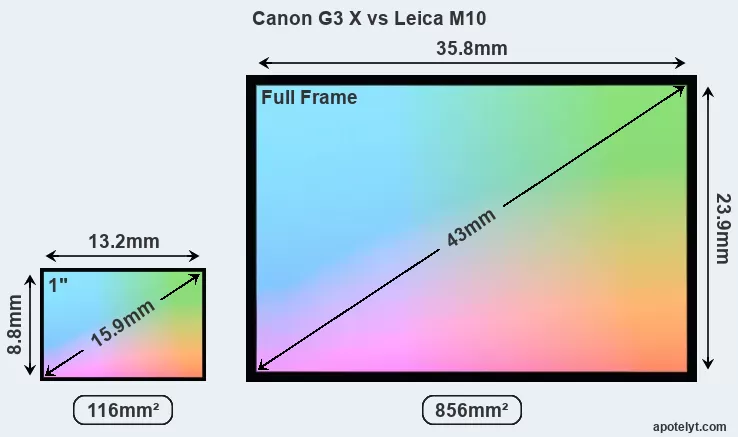
With 23.8MP, the M10 offers a higher resolution than the G3X (20MP), but the M10 nevertheless has larger individual pixels (pixel pitch of 6.00μm versus 2.41μm for the G3X) due to its larger sensor. Moreover, the M10 is a somewhat more recent model (by 1 year and 7 months) than the G3X, and its sensor might have benefitted from technological advances during this time that further enhance the light gathering capacity of its pixel-units. Coming back to sensor resolution, it should be mentioned that the M10 has no anti-alias filter installed, so that it can capture all the detail its sensor resolves.
The resolution advantage of the Leica M10 implies greater flexibility for cropping images or the possibility to print larger pictures. The maximum print size of the M10 for good quality output (200 dots per inch) amounts to 29.8 x 20 inches or 75.6 x 50.7 cm, for very good quality (250 dpi) 23.8 x 16 inches or 60.5 x 40.6 cm, and for excellent quality (300 dpi) 19.8 x 13.3 inches or 50.4 x 33.8 cm. The corresponding values for the Canon G3 X are 27.4 x 18.2 inches or 69.5 x 46.3 cm for good quality, 21.9 x 14.6 inches or 55.6 x 37.1 cm for very good quality, and 18.2 x 12.2 inches or 46.3 x 30.9 cm for excellent quality prints.
The Canon PowerShot G3 X has a native sensitivity range from ISO 125 to ISO 12800, which can be extended to ISO 125-25600. The corresponding ISO settings for the Leica M10 (Typ 3656) are ISO 100 to ISO 50000 (no boost).
In terms of underlying technology, the G3X is build around a BSI-CMOS sensor, while the M10 uses a CMOS imager. Both cameras use a Bayer filter for capturing RGB colors on a square grid of photosensors. This arrangement is found in most digital cameras.
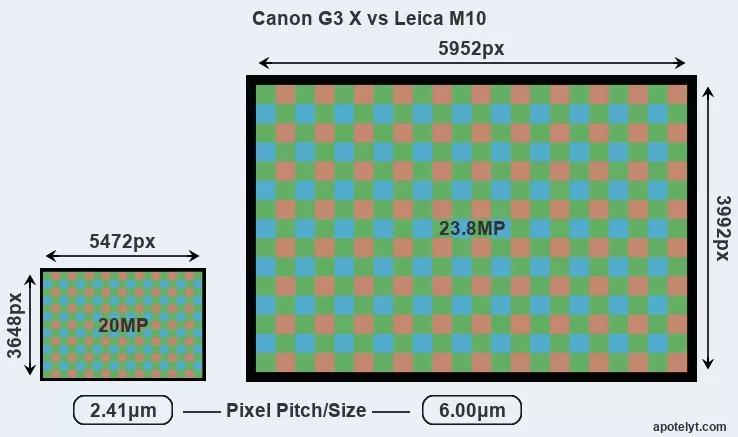
Consistent information on actual sensor performance is available from DXO Mark for many cameras. This service assesses and scores the color depth ("DXO Portrait"), dynamic range ("DXO Landscape"), and low-light sensitivity ("DXO Sports") of camera sensors, and also publishes an overall camera score. Of the two cameras under consideration, the M10 offers substantially better image quality than the G3X (overall score 23 points higher). The advantage is based on 3 bits higher color depth, 0.9 EV in additional dynamic range, and 2 stops in additional low light sensitivity. The following table provides an overview of the physical sensor characteristics, as well as the sensor quality measurements for a selection of comparators.

| # | Camera Model |
Sensor Class |
Resolution (MP) |
Horiz. Pixels |
Vert. Pixels |
Video Format |
DXO Portrait |
DXO Landscape |
DXO Sports |
DXO Overall |
|
|---|---|---|---|---|---|---|---|---|---|---|---|
| 1. | Canon G3 X | 1-inch | 20.0 | 5472 | 3648 | 1080/60p | 21.4 | 12.3 | 521 | 63 | |
| 2. | Leica M10 | Full Frame | 23.8 | 5952 | 3992 | none | 24.4 | 13.2 | 2133 | 86 | |
| 3. | Canon 80D | APS-C | 24.0 | 6000 | 4000 | 1080/60p | 23.6 | 13.2 | 1135 | 79 | |
| 4. | Canon G9 X | 1-inch | 20.0 | 5472 | 3648 | 1080/60p | 21.5 | 12.3 | 495 | 63 | |
| 5. | Canon G7 X | 1-inch | 20.0 | 5472 | 3648 | 1080/60p | 23.0 | 12.7 | 556 | 71 | |
| 6. | Canon 70D | APS-C | 20.0 | 5472 | 3648 | 1080/30p | 22.5 | 11.6 | 926 | 68 | |
| 7. | Leica M11 | Full Frame | 60.3 | 9528 | 6328 | none | 26.3 | 14.8 | 3376 | 100 | |
| 8. | Leica M-E Typ 240 | Full Frame | 23.7 | 5952 | 3976 | 1080/25p | 25.2 | 14.2 | 2821 | 94 | |
| 9. | Leica M10-P | Full Frame | 23.8 | 5952 | 3992 | none | 25.1 | 14.1 | 2739 | 93 | |
| 10. | Leica M Typ 262 | Full Frame | 23.7 | 5952 | 3976 | none | 24.8 | 13.7 | 2478 | 90 | |
| 11. | Leica M Typ 240 | Full Frame | 23.7 | 5952 | 3976 | 1080/25p | 24.0 | 13.3 | 1860 | 84 | |
| 12. | Panasonic FZ2500 | 1-inch | 20.0 | 5472 | 3648 | 4K/30p | 23.0 | 12.6 | 538 | 70 | |
| 13. | Panasonic FZ1000 | 1-inch | 20.0 | 5472 | 3648 | 4K/30p | 22.1 | 11.7 | 517 | 64 | |
| 14. | Sony RX10 III | 1-inch | 20.0 | 5472 | 3648 | 4K/30p | 23.1 | 12.6 | 472 | 70 | |
| 15. | Sony RX100 V | 1-inch | 20.0 | 5472 | 3648 | 4K/30p | 22.8 | 12.4 | 586 | 70 | |
| 16. | Sony RX10 II | 1-inch | 20.0 | 5472 | 3648 | 4K/30p | 23.0 | 12.6 | 531 | 70 | |
| 17. | Sony RX10 | 1-inch | 20.0 | 5472 | 3648 | 1080/60p | 22.9 | 12.6 | 474 | 69 | |
| Note: DXO values in italics represent estimates based on sensor size and age. | |||||||||||
Many modern cameras are not only capable of taking still images, but can also record movies. The G3X indeed provides movie recording capabilities, while the M10 does not. The highest resolution format that the G3X can use is 1080/60p.
Feature comparison
Apart from body and sensor, cameras can and do differ across a variety of features. For example, the M10 has an optical viewfinder, which can be very useful when shooting in bright sunlight. In contrast, the G3X relies on live view and the rear LCD for framing. That said, the G3X can be equipped with an optional viewfinder – the EVF-DC1. The adjacent table lists some of the other core features of the Canon G3 X and Leica M10 along with similar information for a selection of comparators.

| # | Camera Model |
Viewfinder (Type or 000 dots) |
Control Panel (yes/no) |
LCD Specifications (inch/000 dots) |
LCD Attach- ment |
Touch Screen (yes/no) |
Max Shutter Speed * |
Max Shutter Flaps * |
Built-in Flash (yes/no) |
Built-in Image Stab |
|
|---|---|---|---|---|---|---|---|---|---|---|---|
| 1. | Canon G3 X | optional | n | 3.2 / 1620 | tilting | Y | 1/2000s | 5.9/s | Y | Y | |
| 2. | Leica M10 | optical | n | 3.0 / 1037 | fixed | n | 1/4000s | 5.0/s | n | n | |
| 3. | Canon 80D | optical | Y | 3.0 / 1040 | swivel | Y | 1/8000s | 7.0/s | Y | n | |
| 4. | Canon G9 X | none | n | 3.0 / 1040 | fixed | Y | 1/2000s | 6.0/s | Y | Y | |
| 5. | Canon G7 X | none | n | 3.0 / 1040 | tilting | Y | 1/2000s | 6.5/s | Y | Y | |
| 6. | Canon 70D | optical | Y | 3.0 / 1040 | swivel | Y | 1/8000s | 7.0/s | Y | n | |
| 7. | Leica M11 | optical | n | 3.0 / 2333 | fixed | Y | 1/4000s | 4.5/s | n | n | |
| 8. | Leica M-E Typ 240 | optical | n | 3.0 / 920 | fixed | n | 1/4000s | 3.0/s | n | n | |
| 9. | Leica M10-P | optical | n | 3.0 / 1037 | fixed | Y | 1/4000s | 5.0/s | n | n | |
| 10. | Leica M Typ 262 | optical | n | 3.0 / 921 | fixed | n | 1/4000s | 3.0/s | n | n | |
| 11. | Leica M Typ 240 | optical | n | 3.0 / 920 | fixed | n | 1/4000s | 3.0/s | n | n | |
| 12. | Panasonic FZ2500 | 2360 | n | 3.0 / 1040 | swivel | Y | 1/4000s | 12.0/s | Y | Y | |
| 13. | Panasonic FZ1000 | 2359 | n | 3.0 / 921 | swivel | n | 1/4000s | 12.0/s | Y | Y | |
| 14. | Sony RX10 III | 2359 | Y | 3.0 / 1229 | tilting | n | 1/2000s | 14.0/s | Y | Y | |
| 15. | Sony RX100 V | 2359 | n | 3.0 / 1229 | tilting | n | 1/2000s | 24.0/s | Y | Y | |
| 16. | Sony RX10 II | 2359 | Y | 3.0 / 1229 | tilting | n | 1/3200s | 14.0/s | Y | Y | |
| 17. | Sony RX10 | 1440 | Y | 3.0 / 1229 | tilting | n | 1/3200s | 10.0/s | Y | Y | |
| Note: *) Information refers to the mechanical shutter, unless the camera only has an electronic one. | |||||||||||
One difference between the cameras concerns the presence of an on-board flash. The G3X has one, while the M10 does not. While the built-in flash of the G3X is not very powerful, it can at times be useful as a fill-in light.
The G3X has an articulated LCD that can be turned to be front-facing. This characteristic will be appreciated by vloggers and photographers who are interested in snapping selfies. In contrast, the M10 does not have a selfie-screen.The Leica M10 has an intervalometer built-in. This enables the photographer to capture time lapse sequences, such as flower blooming, a sunset or moon rise, without purchasing an external camera trigger and related software.
Concerning the storage of imaging data, both the G3X and the M10 write their files to SDXC cards. Both cameras can use UHS-I cards, which provide for Ultra High Speed data transfer of up to 104 MB/s.
Connectivity comparison
For some imaging applications, the extent to which a camera can communicate with its environment can be an important aspect in the camera decision process. The table below provides an overview of the connectivity of the Canon PowerShot G3 X and Leica M10 (Typ 3656) and, in particular, the interfaces the cameras (and selected comparators) provide for accessory control and data transfer.

| # | Camera Model |
Hotshoe Port |
Internal Mic / Speaker |
Microphone Port |
Headphone Port |
HDMI Port |
USB Port |
WiFi Support |
NFC Support |
Bluetooth Support |
|
|---|---|---|---|---|---|---|---|---|---|---|---|
| 1. | Canon G3 X | Y | stereo / mono | Y | Y | mini | 2.0 | Y | Y | - | |
| 2. | Leica M10 | Y | - / - | - | - | - | - | Y | - | - | |
| 3. | Canon 80D | Y | stereo / mono | Y | Y | mini | 2.0 | Y | Y | - | |
| 4. | Canon G9 X | - | stereo / mono | - | - | micro | 2.0 | Y | Y | - | |
| 5. | Canon G7 X | - | stereo / mono | - | - | micro | 2.0 | Y | Y | - | |
| 6. | Canon 70D | Y | stereo / mono | Y | - | mini | 2.0 | Y | - | - | |
| 7. | Leica M11 | Y | - / - | - | - | - | 3.2 | Y | - | Y | |
| 8. | Leica M-E Typ 240 | Y | mono / - | - | - | - | 2.0 | - | - | - | |
| 9. | Leica M10-P | Y | - / - | - | - | - | - | Y | - | - | |
| 10. | Leica M Typ 262 | Y | - / - | - | - | - | 2.0 | - | - | - | |
| 11. | Leica M Typ 240 | Y | stereo / mono | - | - | - | 2.0 | - | - | - | |
| 12. | Panasonic FZ2500 | Y | stereo / mono | Y | Y | micro | 2.0 | Y | - | - | |
| 13. | Panasonic FZ1000 | Y | stereo / mono | Y | - | micro | 2.0 | Y | Y | - | |
| 14. | Sony RX10 III | Y | stereo / mono | Y | Y | micro | 2.0 | Y | Y | - | |
| 15. | Sony RX100 V | - | stereo / mono | - | - | micro | 2.0 | Y | Y | - | |
| 16. | Sony RX10 II | Y | stereo / mono | Y | Y | micro | 2.0 | Y | Y | - | |
| 17. | Sony RX10 | Y | stereo / mono | Y | Y | micro | 2.0 | Y | Y | - |
Both the G3X and the M10 have been discontinued, but can regularly be found used on ebay. The M10 was replaced by the Leica M11, while the G3X does not have a direct successor. Further information on the features and operation of the G3X and M10 can be found, respectively, in the Canon G3 X Manual (free pdf) or the online Leica M10 Manual.
Review summary
So what conclusions can be drawn? Is there a clear favorite between the Canon G3 X and the Leica M10? Which camera is better? Below is a summary of the relative strengths of each of the two contestants.

Advantages of the Canon PowerShot G3 X:
- Better moiré control: Has an anti-alias filter to avoid artificial patterns to appear in images.
- Broader imaging potential: Can record not only still images but also 1080/60p movies.
- Larger screen: Has a bigger rear LCD (3.2" vs 3.0") for image review and settings control.
- More detailed LCD: Has a higher resolution rear screen (1620k vs 1037k dots).
- More flexible LCD: Has a tilting screen for odd-angle shots in landscape orientation.
- Fewer buttons to press: Is equipped with a touch-sensitive rear screen to facilitate handling.
- More selfie-friendly: Has an articulated screen that can be turned to be front-facing.
- Faster burst: Shoots at higher frequency (5.9 vs 5 flaps/sec) to capture the decisive moment.
- Ready to shoot: Has a lens built-in, whereas the M10 requires a separate lens.
- More compact: Is smaller (123x77mm vs 139x80mm) and thus needs less room in the bag.
- Longer lasting: Can take more shots (300 versus 210) on a single battery charge.
- Sharper images: Has hand-shake reducing image stabilization built-in.
- Easier fill-in: Is equipped with a small onboard flash to brighten deep shadow areas.
- Easier device pairing: Supports NFC for fast wireless image transfer over short distances.
- More affordable: Was introduced at a lower price, despite coming with a built-in lens.
- More heavily discounted: Has been on the market for longer (launched in June 2015).

Arguments in favor of the Leica M10 (Typ 3656):
- More detail: Has more megapixels (23.8 vs 20MP), which boosts linear resolution by 9%.
- Maximized detail: Lacks an anti-alias filter to exploit the sensor's full resolution potential.
- Better image quality: Scores substantially higher (23 points) in the DXO overall evaluation.
- Richer colors: Generates noticeably more natural colors (3 bits more color depth).
- More dynamic range: Captures a broader range of light and dark details (0.9 EV of extra DR).
- Better low-light sensitivity: Can shoot in dim conditions (2 stops ISO advantage).
- Easier framing: Has an optical viewfinder for image composition and settings control.
- Faster shutter: Has higher mechanical shutter speed (1/4000s vs 1/2000s) to freeze action.
- Easier time-lapse photography: Has an intervalometer built-in for low frequency shooting.
- More flexible: Takes interchangeable lenses and can thus be used with different optics.
- More prestigious: Has the Leica luxury appeal, which ensures a high resale value.
- More modern: Was introduced somewhat (1 year and 7 months) more recently.
If the number of relative strengths (bullet points above) is taken as a guide, the G3X is the clear winner of the match-up (16 : 12 points). However, the relevance of individual strengths will vary across photographers, so that you might want to apply your own weighing scheme to the summary points when reflecting and deciding on a new camera. A professional wildlife photographer will view the differences between cameras in a way that diverges from the perspective of a family photog, and a person interested in architecture has distinct needs from a sports shooter. Hence, the decision which camera is best and worth buying is often a very personal one.
In any case, while the comparison of technical specifications can provide a useful overview of the capabilities of different cameras, it remains partial and cannot reveal, for example, the shooting experience and imaging performance when actually working with the G3X or the M10. User reviews that are available, for instance, at amazon can sometimes shed light on these issues, but such feedback is all too often partial, inconsistent, and inaccurate.
Expert reviews
This is where reviews by experts come in. The adjacent summary-table relays the overall verdicts of several of the most popular camera review sites (amateurphotographer [AP], cameralabs [CL], digitalcameraworld [DCW], dpreview [DPR], ephotozine [EPZ], photographyblog [PB]). As can be seen, the professional reviewers agree in many cases on the quality of different cameras, but sometimes their assessments diverge, reinforcing the earlier point that a camera decision is often a very personal choice.

| # | Camera Model |
AP score |
CL score |
DCW score |
DPR score |
EPZ score |
PB score |
Camera Launch |
Launch Price (USD) |
Street Price |
|
|---|---|---|---|---|---|---|---|---|---|---|---|
| 1. | Canon G3 X | 3.5/5 | + | .. | .. | 4.5/5 | 4/5 | Jun 2015 | 999 | ebay.com | |
| 2. | Leica M10 | 4.5/5 | .. | .. | .. | 4/5 | 4.5/5 | Jan 2017 | 6,595 | ebay.com | |
| 3. | Canon 80D | 4/5 | + + | 4.5/5 | 84/100 | 4.5/5 | 4.5/5 | Feb 2016 | 1,199 | ebay.com | |
| 4. | Canon G9 X | 3.5/5 | + + | .. | .. | 4.5/5 | 4.5/5 | Oct 2015 | 529 | ebay.com | |
| 5. | Canon G7 X | 4/5 | + + | .. | 77/100 | 4.5/5 | 4.5/5 | Sep 2014 | 699 | ebay.com | |
| 6. | Canon 70D | 5/5 | + + | .. | 83/100 | 4.5/5 | 5/5 | Jul 2013 | 1,199 | ebay.com | |
| 7. | Leica M11 | 4.5/5 | .. | 4.5/5 | .. | 4.5/5 | 4.5/5 | Jan 2022 | 8,995 | amazon.com | |
| 8. | Leica M-E Typ 240 | .. | .. | .. | .. | .. | .. | Jun 2019 | 3,999 | ebay.com | |
| 9. | Leica M10-P | .. | .. | 3/5 | .. | .. | 4/5 | Aug 2018 | 7,995 | ebay.com | |
| 10. | Leica M Typ 262 | .. | .. | .. | .. | .. | .. | Nov 2015 | 5,195 | ebay.com | |
| 11. | Leica M Typ 240 | 4/5 | .. | .. | .. | 4/5 | .. | Sep 2012 | 6,950 | ebay.com | |
| 12. | Panasonic FZ2500 | .. | + | .. | 82/100 | 4.5/5 | 5/5 | Sep 2016 | 1,199 | amazon.com | |
| 13. | Panasonic FZ1000 | 4/5 | + + | .. | 82/100 | 4.5/5 | 4.5/5 | Jun 2014 | 899 | ebay.com | |
| 14. | Sony RX10 III | 5/5 | + | .. | 84/100 | 4.5/5 | 4.5/5 | Mar 2016 | 1,499 | ebay.com | |
| 15. | Sony RX100 V | 4.5/5 | + + | .. | 83/100 | 4/5 | 4.5/5 | Oct 2016 | 999 | ebay.com | |
| 16. | Sony RX10 II | 5/5 | + + | .. | 82/100 | 4.5/5 | 4/5 | Jun 2015 | 1,299 | ebay.com | |
| 17. | Sony RX10 | 5/5 | + | .. | 80/100 | 4.5/5 | 4.5/5 | Oct 2013 | 1,299 | ebay.com | |
| Note: (+ +) highly recommended; (+) recommended; (o) reviewed; (..) not available. | |||||||||||
The above review scores should be interpreted with care, though. The ratings are only valid when referring to cameras in the same category and of the same age. Thus, a score needs to be put into the context of the launch date and the launch price of the camera, and rating-comparisons among cameras that span long time periods or concern very differently equipped models make little sense. Also, please note that some of the review sites have changed their methodology and reporting over time.

Check G3X offers at
ebay.com

Check M10 offers at
ebay.com
Other camera comparisons
Did this review help to inform your camera decision process? In case you are interested in seeing how other cameras pair up, just make your choice using the following search menu. As an alternative, you can also directly jump to any one of the listed comparisons that were previously generated by the CAM-parator tool.
- Canon 5D Mark II vs Canon G3 X
- Canon 70D vs Leica M10
- Canon G3 X vs Canon G5 X Mark II
- Canon G3 X vs Olympus E-510
- Canon G3 X vs Panasonic FZ2000
- Canon G3 X vs Panasonic GH5s
- Canon G3 X vs Sony A77
- Fujifilm X-T30 vs Leica M10
- Leica M10 vs Olympus E-M1X
- Leica M10 vs Olympus E-PM2
- Leica M10 vs Panasonic GX800
- Leica M10 vs Sony NEX-5
Specifications: Canon G3 X vs Leica M10
Below is a side-by-side comparison of the specs of the two cameras to facilitate a quick review of their differences and common features.
| Camera Model | Canon G3 X | Leica M10 |
|---|---|---|
| Camera Type | Fixed lens compact camera | Rangefinder camera |
| Camera Lens | 24-600mm f/2.8-5.6 | Leica M mount lenses |
| Launch Date | June 2015 | January 2017 |
| Launch Price | USD 999 | USD 6,595 |
| Sensor Specs | Canon G3 X | Leica M10 |
| Sensor Technology | BSI-CMOS | CMOS |
| Sensor Format | 1" Sensor | Full Frame Sensor |
| Sensor Size | 13.2 x 8.8 mm | 35.8 x 23.9 mm |
| Sensor Area | 116.16 mm2 | 855.62 mm2 |
| Sensor Diagonal | 15.9 mm | 43 mm |
| Crop Factor | 2.7x | 1.0x |
| Sensor Resolution | 20 Megapixels | 23.8 Megapixels |
| Image Resolution | 5472 x 3648 pixels | 5952 x 3992 pixels |
| Pixel Pitch | 2.41 μm | 6.00 μm |
| Pixel Density | 17.18 MP/cm2 | 2.78 MP/cm2 |
| Moiré control | Anti-Alias filter | no AA filter |
| Movie Capability | 1080/60p Video | no Video |
| ISO Setting | 125 - 12,800 ISO | 100 - 50,000 ISO |
| ISO Boost | 125 - 25,600 ISO | no Enhancement |
| Image Processor | DIGIC 6 | Maestro II |
| DXO Sensor Quality (score) | 63 | 86 |
| DXO Color Depth (bits) | 21.4 | 24.4 |
| DXO Dynamic Range (EV) | 12.3 | 13.2 |
| DXO Low Light (ISO) | 521 | 2133 |
| Screen Specs | Canon G3 X | Leica M10 |
| Viewfinder Type | Viewfinder optional | Optical viewfinder |
| Viewfinder Field of View | 100% | |
| Viewfinder Magnification | 0.73x | |
| LCD Framing | Live View | Live View |
| Rear LCD Size | 3.2inch | 3.0inch |
| LCD Resolution | 1620k dots | 1037k dots |
| LCD Attachment | Tilting screen | Fixed screen |
| Touch Input | Touchscreen | no Touchscreen |
| Shooting Specs | Canon G3 X | Leica M10 |
| Focus System | Contrast-detect AF | Manual Focus |
| Manual Focusing Aid | Focus Peaking | Focus Peaking |
| Max Shutter Speed (mechanical) | 1/2000s | 1/4000s |
| Continuous Shooting | 5.9 shutter flaps/s | 5 shutter flaps/s |
| Time-Lapse Photography | no Intervalometer | Intervalometer built-in |
| Fill Flash | Built-in Flash | no On-Board Flash |
| Storage Medium | SDXC cards | SDXC cards |
| Single or Dual Card Slots | Single card slot | Single card slot |
| UHS card support | UHS-I | UHS-I |
| Connectivity Specs | Canon G3 X | Leica M10 |
| External Flash | Hotshoe | Hotshoe |
| USB Connector | USB 2.0 | no USB |
| HDMI Port | mini HDMI | no HDMI |
| Microphone Port | External MIC port | no MIC socket |
| Headphone Socket | Headphone port | no Headphone port |
| Wifi Support | Wifi built-in | Wifi built-in |
| Near-Field Communication | NFC built-in | no NFC |
| Body Specs | Canon G3 X | Leica M10 |
| Environmental Sealing | Weathersealed body | Weathersealed body |
| Battery Type | Canon NB-10L | Leica BP-SCL5 |
| Battery Life (CIPA) | 300 shots per charge | 210 shots per charge |
| Body Dimensions |
123 x 77 x 105 mm (4.8 x 3.0 x 4.1 in) |
139 x 80 x 39 mm (5.5 x 3.1 x 1.5 in) |
| Camera Weight | 733 g (25.9 oz) | 660 g (23.3 oz) |

Check G3X offers at
ebay.com

Check M10 offers at
ebay.com
Did you notice an error on this page? If so, please get in touch, so that we can correct the information.

